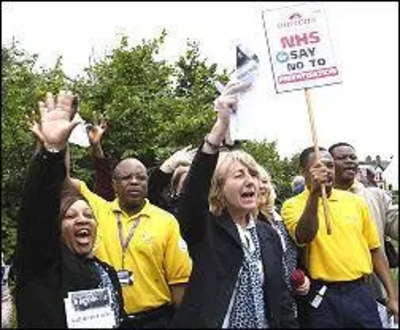NHS DEFECITS - Where has all the extra Government money for the NHS gone?

Despite considerable investment since Labour came to power, the NHS has a final audited deficit for 2005-06 of £547 million. So where has all the money gone?
In response to this news, Lib Dem Parliamentary Spokesperson, Cllr Rosie Sharpley said:
"The number of Trusts in serious debt has more than trebled in the past year with severe knock-on effects on the local health economy with hospitals being pitted against each other in a struggle to survive cuts.
The Government repeatedly claim that this debt will not affect patient care. Yet this year there have been thousands of jobs cut and many wards closed. In June 2006 Sir Ian Carruthers, acting Chief Executive of the NHS said he could not rule out the closure of whole hospitals."
Find the figures by Trust at:-
http://www.dh.gov.uk/assetRoot/04/13/95/51/04139551.pdf
The losses in the South East Coast Strategic Health Authority Economy total over £94 million. These are shown in total by Health Trust and PCT on page 8 of the above report. The impact on our area is therefore potentially very severe.
The Government's Responsibility?
Yes.
· There is no national overview/framework of the difficulties experienced by hospitals. Three regions have particular problems (London, South East and the East of England).The Government blames deficits entirely on local management, yet it is they who have unleashed powerful market-based forces onto the NHS without indicating an overall plan for their changes.
· There is no clarity about the extent of the difficulties as we lack the full picture of the extent of the deficits. This year's figures include planned borrowing from the NHS Bank which would have to be repaid at sometime and cash savings. Some hospital trusts currently reporting no deficit are situated in a local health economy reporting deficits at PCT level, which would have a knock on effect on them which means that deficit figures cannot be taken at face value until they include the bigger picture.
· Endless government reforms threaten the stability of hospitals. The hectic pace of these reforms means that Managers do not have the time and stability to effectively plan their services. The financial framework for 2006/07 was radically changed by top-slicing of Trust budgets just weeks before the start of the financial year while the tariffs payable were still being negotiated after the financial year had begun.
· Pressure from the Government to prioritise targets has led to hospital trusts overspending to meet them and then being condemned for poor financial management.
· Local communities have no real say in their local NHS. People have protested about cuts to no avail and feel disconnected from their own health services as a result. There is no meaningful debate about the future of local services as all too often changes are imposed from above regardless of the strength of local feeling.
· The Government refuses to take responsibility for the problems in the NHS. The Secretary of State, Patricia Hewitt continually denies that there is a problem despite continuing evidence. NAO reports in 2005 and in 2006 have attributed hospital financial difficulties in some part to Government policy. Yet the Government blames all deficits on local management and efficiency.
What would the Liberal Democrats do?
1. Give local people a real say over their health services by decentralising decision making to locally accountable bodies. By ensuring that local communities are part of the long term NHS planning in their area, any changes in the location of service provision would truly reflect the needs of the area. One of the biggest barriers to making the NHS better is the huge gap between the people in power ( Ministers) and the patients. The democratic deficit in health means that if local people are not happy about how local health priorities are set, there is no local person who they elect who is accountable for those priorities.
2. Provide a clear national picture of the state of the NHS. Our research over the summer, for the first time, a detailed national overview of the relative position of Trusts in different parts of the country. It combines data at acute trust level, PCT level and SHA level and takes account of local factors such as proximity to other NHS and private treatment providers. If the role of the DOH is to provide a strategic overview and plan for the NHS, it is hard to see how it can do this when it knows so little about the overall pattern of pressures in the NHS.
3. Scale back the number and pace of highly disruptive centrally mandated reforms and end the Government's target obsession. The NHS has suffered from too much reform at too fast a pace with little clear long-term direction and an emphasis on meeting targets over anything else, leaving little time for Trusts to plan their services around those targets. Too much of their recourses are being channelled into dealing with change in the system, rather than ensuring for their own best management and patient care.